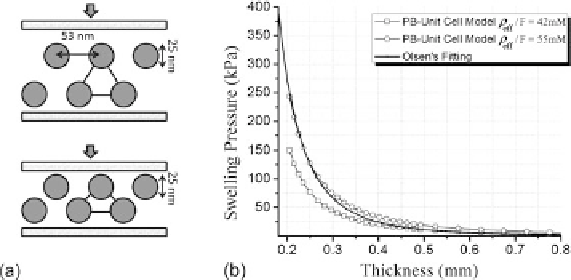Biomedical Engineering Reference
In-Depth Information
Fig. 2.3
(
a
) 2D illustration of the unit cell, charge distribution is uniform over the interstitial region
Ω
s
. The tissue is deformed by pressing the porous piston and the deformed unit cell is calculated
from affine mapping; (
b
) Swelling pressure computed by PB-unit cell model based on collagen
volume exclusion. The charge density is calibrated to be
ρ
eff
/F
=
55 mM. The lower and
upper bound of the
ρ
eff
are determined by fitting the result at physiological situation (
t
=
42
∼
0
.
5mm)
and the low hydration situation (
t
=
0
.
2 mm) respectively. The interfibril spacing
l
c
=
53 nm and
the collagen radius
r
f
=
12
.
5nm
the total fixed charge
Q
f
is conserved and the charge density computed from
ρ
i
f
=
Q
f
/V
f
, where
V
f
is the volume of
Ω
i
f
. The results are shown in Fig.
2.3
(b) and
labeled in terms of effective charge density
ρ
eff
defined by
ρ
f
V
f
V
0
,
ρ
eff
=
(2.17)
where
V
0
is the total volume of the unit cell including the fibril volume at physiolog-
ical thickness. Values of
ρ
eff
/F
42 mM and 55 mM give best fits at physiological
and low hydration, respectively, and produce predictions that are dramatically better
than those of Donnan theory.
=
2.3 The Case for a PG-Coating of the Collagen Fibrils
Fratzl and Daxer (
1993
) describe X-ray scattering studies to measure the structural
transformation of collagen fibrils under varying hydration produced by drying the
tissue. The data strongly suggests that stromal PGs are heterogeneously distributed
in the interfibrillar space. They appear in relatively high density in the vicinity of
the fibrils where they may form a charge-rich effective PG coating surrounding each
fibril. Hodson (
1971
) and Twersky (
1975
) have, much earlier, speculated on the ex-
istence of a such a fibril coating. Fratzl and Daxer (
1993
) estimated the radius of
the coating as
r
c
=
18 nm. Interestingly, they showed that the coating radius
r
c
is
insensitive to hydration over a wide range and this suggests that the charge density
associated with the coating PGs will not change with variations in hydration. How-
ever, at low levels of hydration the coatings may overlap and interact, as described
below.

